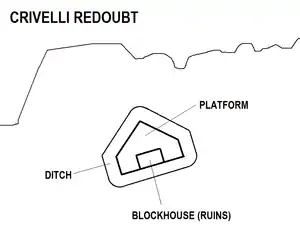Crivelli Redoubt
Crivelli Redoubt (Maltese: Ridott ta' Crivelli), also known as Barriera Redoubt (Maltese: Ridott tal-Barriera) or Armier Redoubt (Maltese: Ridott tal-Armier), is a redoubt in Armier Bay, limits of Mellieħa, Malta. It was built by the Order of Saint John in 1715–1716 as one of a series of coastal fortifications around the Maltese Islands. Today, the redoubt is in good condition.
| Crivelli Redoubt | |
|---|---|
Ridott ta' Crivelli | |
| Mellieħa, Malta | |
 Map of Crivelli Redoubt | |
| Coordinates | 35°59′20.7″N 14°21′29.1″E |
| Type | Redoubt |
| Site information | |
| Owner | Government of Malta |
| Controlled by | Private tenant |
| Open to the public | No |
| Condition | Intact |
| Site history | |
| Built | 1715–1716 |
| Built by | Order of Saint John |
| Materials | Limestone |
In the early 19th century, Crivelli Redoubt was also known as La Canniere Redoubt.[1]
History
Crivelli Redoubt was built in 1715–1716 as part of the first building programme of coastal fortifications in Malta. It was part of a chain of fortifications that defended the northern coast of Malta, which also included Aħrax Tower, several batteries, redoubts and entrenchments. The nearest fortifications to Crivelli Redoubt are Vendôme Battery to the west and the Louvier Entrenchment to the east.
The redoubt was named after the Prior of Capua, Ferdinando Crivelli, who financed the 955.20.11.1 scudi needed for its construction. It was probably designed by the French engineer Philip Maigret.[2]
The redoubt consists of a pentagonal platform with a low parapet. A rectangular blockhouse with two rooms is located at the centre of its gorge, and the main entrance has an inscription making reference to the knight Crivelli. The redoubt is surrounded by a ditch, which is partially rock hewn. It was not armed with any artillery.[3]
Present day
By the early 21st century, the redoubt was in ruins, with the left wall and part of the roof of the blockhouse having collapsed, with the facade being unstable. The damage has since been repaired.
Crivelli Redoubt is the best preserved redoubt in Mellieħa, since the others have been demolished or are in a worse state of preservation.[3]
References
- de Boisgelin, Louis (1805). Ancient and Modern Malta: Containing a Full and Accurate Account of the Present State of the Islands of Malta and Goza, the History of the Knights of St. John of Jerusalem, Also a Narrative of the Events which Attended the Capture of These Islands by the French, and Their Conquest by the English: and an Appendix, Containing Authentic State Papers and Other Documents - Volume II. London: Richard Phillips. p. 190.
- Said, Edward (October 2009). "More Heritage Threatened" (PDF). The Architect. p. 20. Archived from the original (PDF) on 21 June 2015.
- Debono, Charles. "Fortifications - Armier Redoubt". Mellieha.com. Retrieved 21 June 2015.